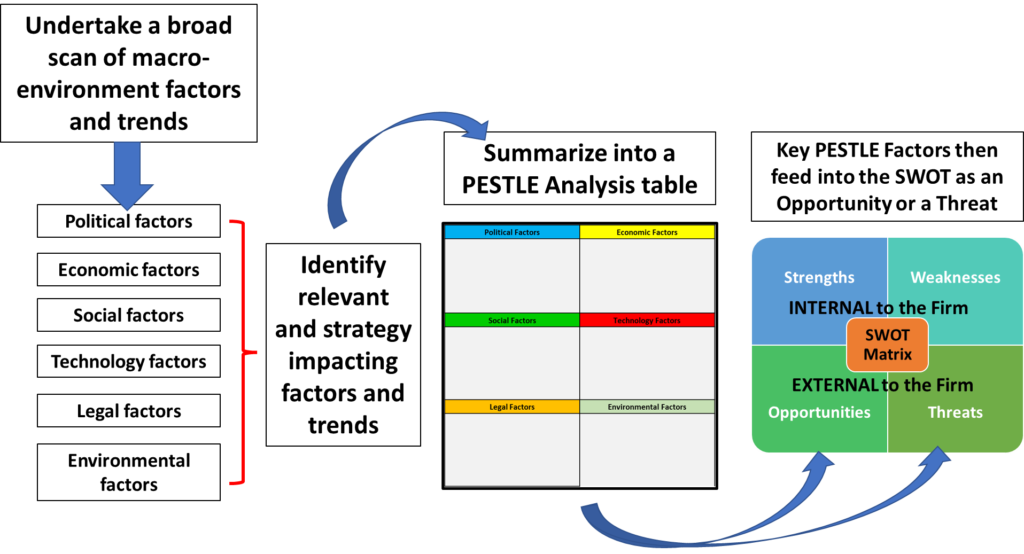Topics
-
PESTLE analysis, marketing environment, macro-environment, SWOT analysis
Review the activity below or download the PDF student worksheet
- Student Worksheet: PESTLE Analysis – What Goes Where
- Instructor Solutions (Members Only): PESTLE Analysis: What Goes Where? = Solutions
- Download Editable Slides (Long-term Members Only):
Student Discussion Activity
PESTLE analysis is commonly used to organize the review of relevant macro-environment trends and factors into a simple summary table.
From there, we can assess the potential impact of the factor or trend as either positive or negative and classify it accordingly (as an Opportunity or as a Threat) into our SWOT matrix, as per the following diagram.
Your Task
In this activity, you are presented with four sets containing 12 environmental factors each. Your task is to classify each factor to the most appropriate component of the PESTLE analysis structure.
Please note that in each set of ten factors statements there are always:
- two political factors,
- two economic factors,
- two social factors,
- two technology factors,
- two legal factors, and
- two environmental factors
Simple work through the following sets of macro-environment factors and classify each factor into the appropriate component of PESTLE matrix, allocating two per box per set – for Sets A to D below.
PESTLE Factors Set A
- Broadening social media platform options
- Clearly defined social class structure
- Decreasing family sizes (less children per couple)
- Easy to borrow money
- High inflation rate
- Increasing government spending
- Industry-based regulation
- Negative impacts from climate change
- Recent change of government
- Shift to recyclable packaging
- Shortening technology lifetime
- Strong copyright and patent laws
PESTLE Factors Set B
- Accreditation requirements for staff
- Advancing AI tools
- Consumer preference for green products
- Favorable trade agreements established
- Fluctuating stock market conditions
- Greater access to big data
- High level of government welfare support
- Local brands are preferred by consumers
- Positive attitudes to health and diet
- Pressure to be seen as an ethical company
- Regulation for product safety standards
- Wealth is concentrated among the very wealthy
PESTLE Factors Set C
- Banks are tightening their lending
- Consumers are happy to switch between brands
- Country is open to international investment
- Eating out of home is common
- Greater smart phone capabilities
- Growing risk of online fraud
- High frequency of litigation
- Landfill concerns of product disposal
- Lobbying pressure on the government
- Rising commodity and oil prices
- Scarcity of clean water
- Tough takeover/acquisition rules
PESTLE Factors Set D
- Advancing customer self-serve technology
- Advertising regulations
- Conservative political focus
- Cost burdening regulation
- Easy access to ‘start-up’ funding
- Increased expectation for environmentally products
- Low levels of government grants for businesses
- People tend to save/invest their disposable income
- Pressure to move to a zero-carbon footprint
- Responsible sourcing of materials expected
- Shift to open innovation
- Skill shortages in key industries
Related Activities
